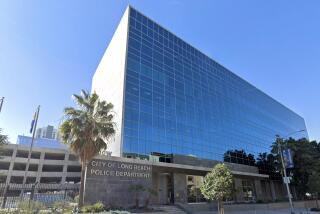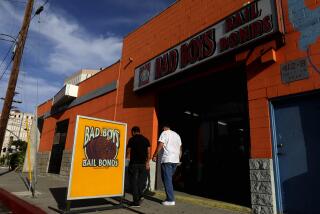Editorial: How California’s Supreme Court called the police unions’ bluff
Last week’s ruling by the California Supreme Court requiring police agencies to make public the names of officers involved in most shootings was a clear victory for public scrutiny and police accountability, both important mainstays of a functioning democracy. The ruling, which held that the Public Records Act does not exempt the names of officers in shootings, has been welcomed by advocates of open government, and clearly demonstrates this court’s embrace of the public’s role in supervising its representatives. (The Times, we should note, was a party to that case, and its lawyers played an important role in securing the decision.)
All of that makes Long Beach Police Officers Assn. vs. City of Long Beach a historic ruling. But the court demonstrated something else in its analysis of the facts and interests that were in play: It looked hard at the most compelling argument against disclosure — that it puts police officers at risk — and saw through the exaggerations and distortions that police unions have used to build sympathy for secrecy.
For years, police unions have fought reasonable efforts to hold officers accountable by claiming that any scrutiny, including the mere release of the name of an officer involved in a shooting, would put their members in danger. In this case, for instance, Lt. Steve James, the Long Beach union president, submitted a declaration warning that the release of the names of officers involved in a 2010 shooting could result in “threats against the well-being of officers or their families.” He mentioned an instance in which an officer received a death threat after his name was made public, and he said the Internet made it simple for anyone to figure out where an officer lived if his or her name was known. Another Long Beach lieutenant amplified those concerns, warning of the possibility of gang retaliation and citing graffiti that advocated violence against police.
It is true: Police work is dangerous; some people attack officers; others would harm them if they could. But as was the case here, police unions and others have tried to turn general animus toward police into specific threats in specific cases. This time, the court called them on it. To the claim that officers might be subject to gang retaliation, the court pointed out that there was no gang involvement in this shooting. The graffiti had nothing to do with this case, and the possibility of threats to officers and their families was entirely speculative. There was, as the court concluded, “no evidence” of any threat of harm or harassment to these officers in this shooting.
The experience of the Los Angeles Police Department also is instructive. For years, the LAPD has released the names of officers involved in almost all shootings. Not once, according to the LAPD, has one of those officers been hurt as a result.
There are — and will be — rare instances in which an officer might legitimately be in danger if his or her name became public. Recognizing that, the court specifically invited agencies to demonstrate that particular danger where it exists, and acknowledged that “the public’s interest in access to public records is not absolute.” But it properly refused to consider “vaguely worded declarations” and “general assertions” as the basis for removing officers from the most basic public scrutiny.
The specificity of those threats is at the center of the task that judges face in evaluating disclosure in these cases, because it affects the balance that courts attempt to strike. Police unions have argued that the competing interests are between the safety of officers and their accountability to the public. Given that, they maintain that officer safety should trump the public’s right to know names. But if the threat to officer safety is merely general or hypothetical, courts are wrong to let it outweigh the principle of public accountability. It is, as the court recognized, important that police be identifiable; that’s part of keeping them honest. It is why they are required by state law to wear an identifying badge.
Good court rulings by conscientious justices rely on the intelligent, evenhanded application of the law and precedent. Great ones combine that process with shrewd understanding of the society they confront. That’s what the California Supreme Court did last week.
More to Read
A cure for the common opinion
Get thought-provoking perspectives with our weekly newsletter.
You may occasionally receive promotional content from the Los Angeles Times.






